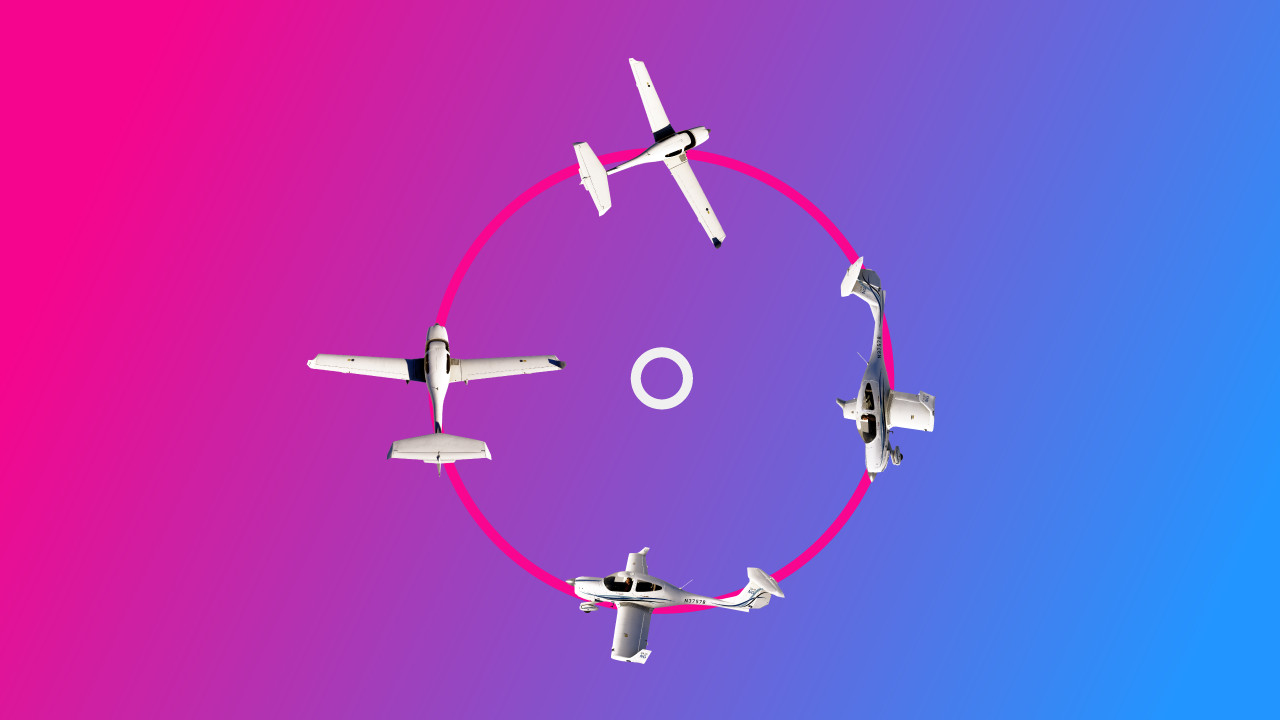-
Key Takeaways
-
What is Adverse Yaw?
-
What Causes Adverse Yaw?
-
Wing Design and Its Effect on Adverse Yaw
-
Why Does Adverse Yaw Happen?
- The Effect of Lift and Induced Drag
- The Effect of Profile Drag
- The Effect of Rolling
-
How to Counteract Adverse Yaw
- Rudder Coordination
- Aircraft Designs for Adverse Yaw
-
Conclusion
You’re flying along and trying to execute a smooth turn when suddenly you feel the aircraft pull slightly in the opposite direction.
Uh oh, what just happened?
That’s called “adverse yaw”, it’s a sneaky little quirk of flying that every pilot has to learn how to manage.
It might sound complicated, but trust that it’s simpler than it seems.
Once you know why it happens and how to manage it, you’ll fly better and enjoy each flight more than the last.
Let’s learn all about adverse yaw and how to handle it.
Key Takeaways
- Adverse yaw is the aircraft’s tendency to yaw in the opposite direction of the turn.
- The lift and drag imbalance between the left and right ailerons creates adverse yaw.
- A pilot can prevent adverse yaw by using rudder, and making sure that a turn is coordinated.
What is Adverse Yaw?
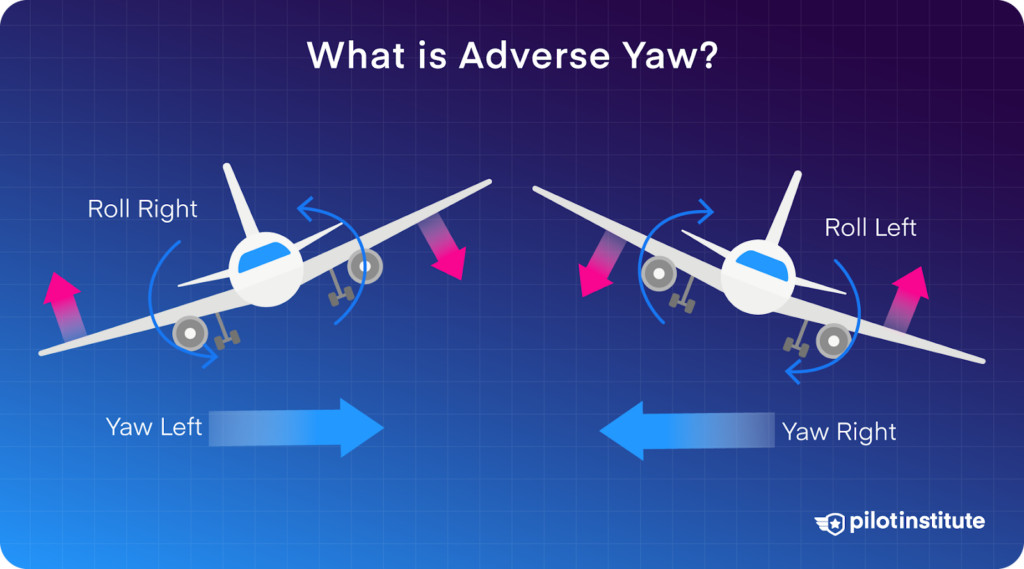
Adverse yaw is the aircraft’s tendency to yaw in the opposite direction of the turn/roll. You’ll remember from basic aerodynamics that yawing is the movement of the aircraft about the normal axis.
Adverse yaw is an undesirable side effect of lift production, resulting in an uncoordinated, slipping turn.
For example, if you bank to the right, the nose of the aircraft will yaw to the left. In this situation, you must add the right rudder to correct for adverse yaw. An easy way to stay coordinated is to look at your turn coordinator and “step on the ball.”
At higher airspeeds, it isn’t much of an issue. However, at low speeds, it poses more of a problem. Consider a turn from base to final.
You’re already close to the stall speed. When you turn, the stall speed increases, and if the aircraft stalls during an uncoordinated stall, it will enter a spin if uncorrected. At low altitudes, a spin is unrecoverable and will have fatal results.
What Causes Adverse Yaw?
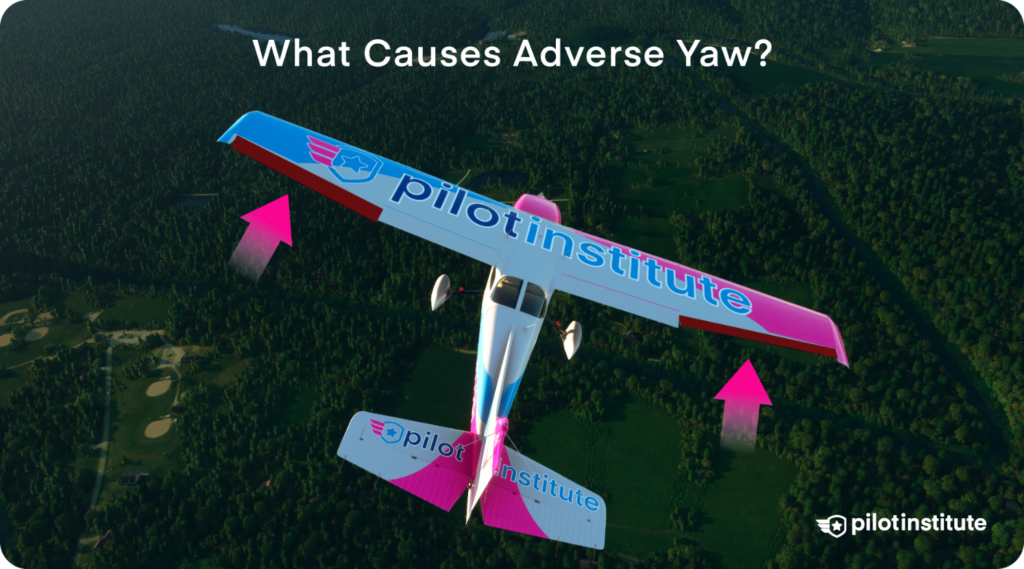
The changes in aerodynamic forces that occur during aileron deflection cause adverse yaw. When an aircraft rolls, the ailerons travel in opposite directions. The deflection of ailerons changes the wing’s Angle of Attack (AOA) and chord line.
To better understand the concept, we will focus on a right-hand turn. In a right-hand turn, the right aileron is raised, and the left aileron is lowered. This creates more lift and drag on the upgoing wing (left) and less on the downgoing (right) wing. The differential lift and drag are the main causes of adverse yaw.
Wing Design and Its Effect on Adverse Yaw
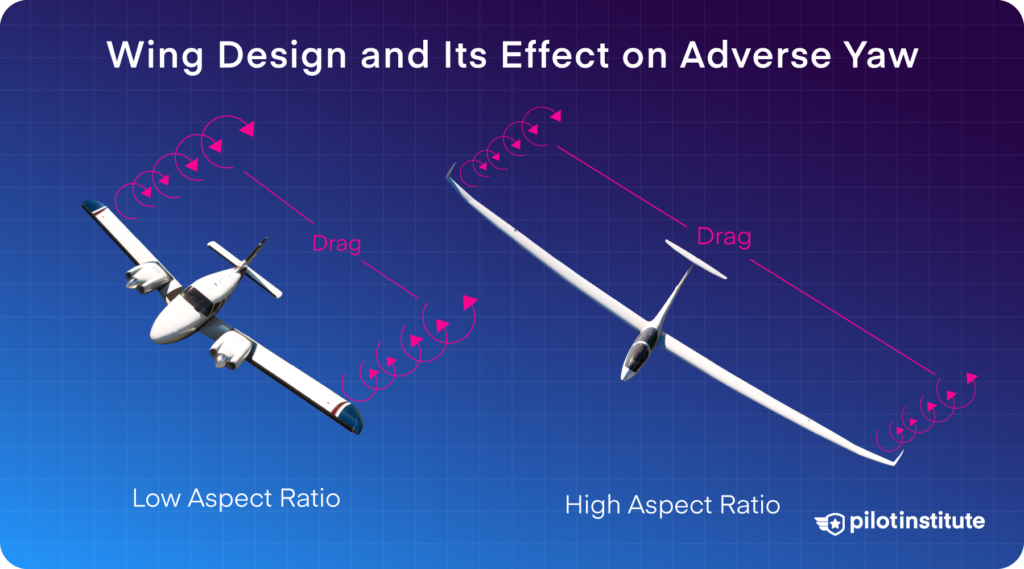
The amount of adverse yaw an aircraft produces depends on the wing’s design. The more lift a wing produces, the more induced drag and the more pronounced the effect.
Low-aspect ratio wings are poor producers of lift. As a result, the effects of adverse yaw are less pronounced on these wings in comparison to high-aspect-ratio wings. These include swept-wings found on Jetliners, which are mainly designed to be effective at the high transonic flight envelope.
Why Does Adverse Yaw Happen?

The Effect of Lift and Induced Drag
When you start a right-hand turn, the left aileron is deflected downward, which increases the angle of attack (AOA) of the wing. The increase in AOA results in an increase in lift. Any increase in lift causes induced drag to increase as well. The increase in drag causes the aircraft’s nose to yaw to the left.
Additionally, in a right turn, the right aileron is deflected upwards. This movement reduces the AOA and lift. So, reducing the induced drag on the right side. The lack of balancing drag on the right-hand side results in a larger yawing moment.
Remember from previous lessons that wingtip vortices are a byproduct of lift and contribute to induced drag. As a result, the upgoing wing will experience larger wingtip vortices that exacerbate the effect of adverse yaw.
The Effect of Profile Drag
The more important aspect is profile drag. An increase in AOA causes an increase in the wing’s effective camber, which in turn causes an increase in profile drag. Profile drag is independent of lift and is a product of the aircraft’s movement through the air. Because of this, it will persist through the turn, providing a constant yawing force in the opposite direction of the turn.
Conversely, the upward deflection of the opposite aileron reduces effective camber. This reduces profile drag, which reduces the balancing force, increasing the effect of adverse yaw towards the left.
The Effect of Rolling
Generally, the effect of the actual wing’s movement through the air is not discussed as often. But the rolling motion also plays a part in producing adverse yaw.
Consider a rolling aircraft that has no forward movement except the rolling moment. In this scenario, the airflow is striking the upper surface of the upgoing wing. As a result, a lift vector is produced from the rolling motion alone.
When the aircraft moves forward, this lift vector moves rearwards due to the effect of the oncoming air. The opposite happens on the downgoing wing, which produces a forward lift component. The net result of the two forces is that they add to the adverse yaw effect.
How to Counteract Adverse Yaw
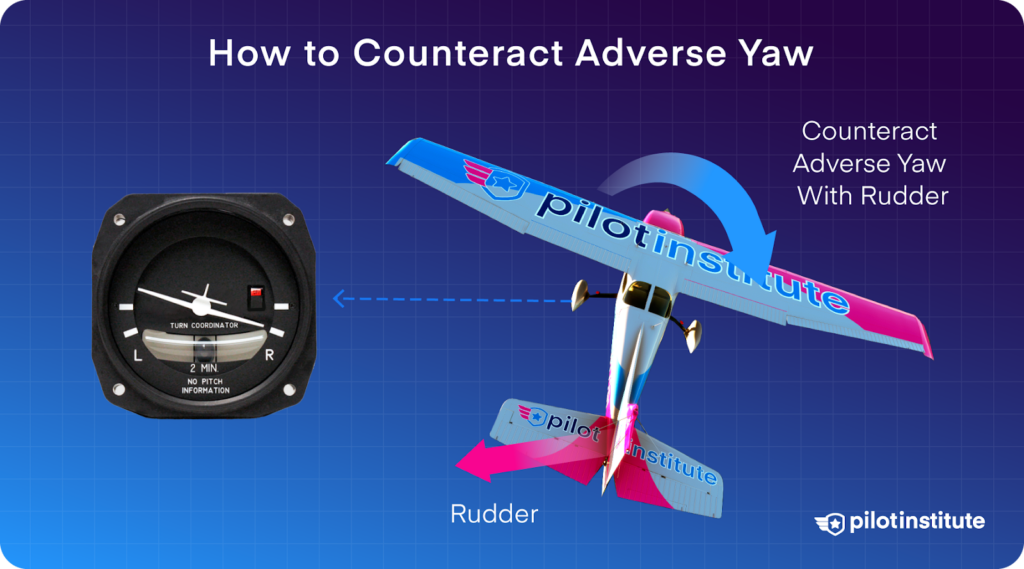
Rudder Coordination
The only way for a pilot to prevent adverse yaw is to ensure the turn is coordinated, which is achieved by using the rudder.
It’s important to understand how your aircraft behaves in a bank. Perform a few turns at varying angles (15, 30, and 45 degrees) to see how adverse yaw affects the aircraft.
Get a feel for how an uncoordinated turn works. Pay special attention to the turn coordinator, which shows the rudder deflection needed to correct the adverse yaw. Experienced pilots won’t need a turn coordinator to feel if the aircraft is slipping or skidding. They can identify it by the forces acting on their bodies, an important skill for student pilots to learn.
Until then, use the indications on the turn coordinator to ensure your turns are coordinated. Remember to “step on the ball”. For example, use left rudder if the ball is deflected to the left.
A common mistake student pilots make is adding too much rudder. This results in the ball going in the opposite direction, prompting them to add opposite rudder instead. Remember, to correct for adverse yaw, always add rudder in the same direction as the turn.
Aircraft Designs for Adverse Yaw
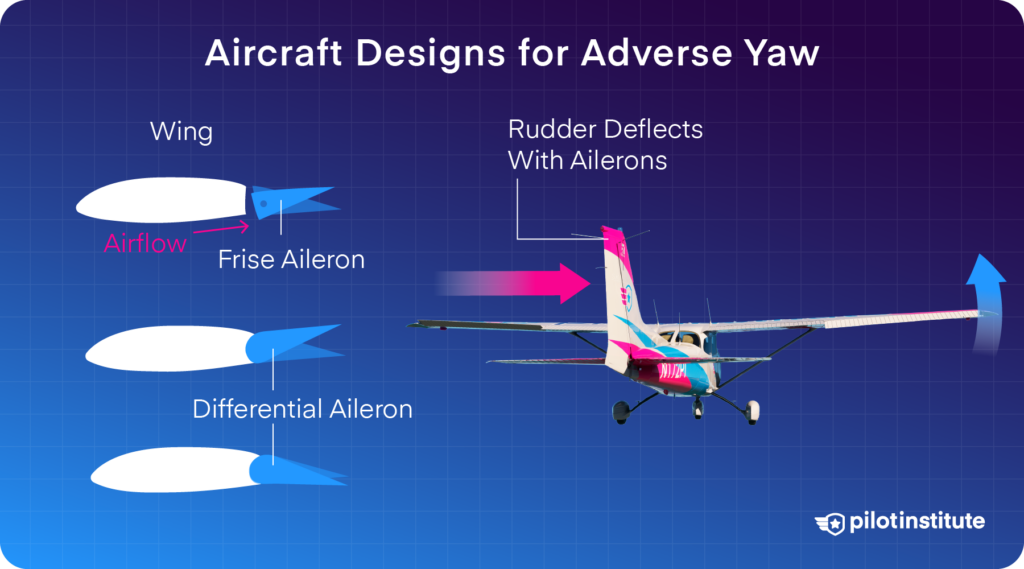
There are multiple methods that aircraft designers apply to reduce the effect of adverse yaw. These include:
Differential Ailerons
The most common method aircraft designers use to combat adverse yaw is to use differential ailerons.
As the name suggests, these ailerons deflect at different angles. The upgoing aileron deflects more than the downgoing aileron. This creates more drag on the downgoing wing, which produces a yawing force in the direction of the turn, counteracting adverse yaw.
Frise Ailerons
Frise ailerons reduce adverse yaw by creating drag on the downgoing wing. These ailerons are often paired with differential ailerons.
The aileron is hinged so that when it is deflected upwards, the leading edge dips down into the airflow on the wing’s underside. This produces parasite drag. The drag acts in the direction of the turn and reduces adverse yaw.
Aileron-Rudder Coupling
Adding rudder during a turn is the most efficient way to prevent adverse yaw. Some aircraft automatically achieve this by connecting the ailerons and rudder using mechanical linkages or electronically with fly-by-wire systems.
However, mechanically coupling the aileron and rudder is inefficient and, as a result, isn’t commonplace. In fly-by-wire systems, the flight computer gauges how much rudder must be added for a given bank angle and airspeed to counteract adverse yaw.
Conclusion
Adverse yaw throws in a little curveball during your turns, but you can easily control it with the right techniques.
The secret? Coordinated rudder input and allowing yourself time to build up your proficiency as a pilot.
Keep the tips we’ve shared with you in mind, and talk with your flight instructor if you have any questions.
Remember, practice makes perfect. Keep flying, keep learning, and let every turn be a testament to your growing skills.

